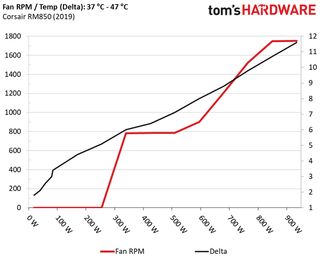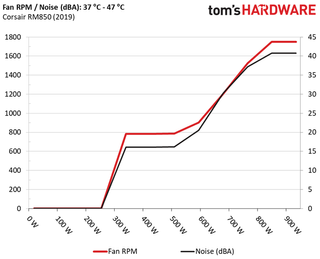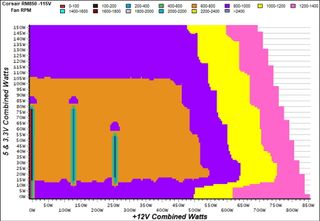Corsair RM850 Power Supply Review: A Solid Value
Why you can trust Tom's Hardware
Load Regulation, Hold-Up Time, Inrush Current, Efficiency and Noise
To learn more about our PSU tests and methodology, please check out How We Test Power Supply Units.
Primary Rails And 5VSB Load Regulation
The following charts show the main rails' voltage values recorded between a range of 40W up to the PSU's maximum specified load, along with the deviation (in percent). Tight regulation is an important consideration every time we review a power supply, because it facilitates constant voltage levels despite varying loads. Tight load regulation also, among other factors, improves the system’s stability, especially under overclocked conditions and, at the same time, it applies less stress to the DC-DC converters that many system components utilize.








The load regulation at +12V is not so impressive, since it goes out of the 1% range. On the minor rails the regulation is better.
Hold-Up Time
Put simply, hold-up time is the amount of time that the system can continue to run without shutting down or rebooting during a power interruption.







The hold-up time is longer than the time that the RM850x achieves, despite the use of smaller, in capacity, bulk caps. Apparently the changes in the platform's design allow for an increased hold-up time. Moreover, the power ok signal is accurate, as we expect in every good power supply.
Inrush Current
Inrush current, or switch-on surge, refers to the maximum, instantaneous input current drawn by an electrical device when it is first turned on. A large enough inrush current can cause circuit breakers and fuses to trip. It can also damage switches, relays, and bridge rectifiers. As a result, the lower the inrush current of a PSU right as it is turned on, the better.


The inrush current is low with 115V input, and a bit on the high side with 230V.
10-110% Load Tests
These tests reveal the RM850’s load regulation and efficiency levels under high ambient temperatures. They also show how the fan speed profile behaves under increased operating temperatures.
| Test # | 12V | 5V | 3.3V | 5VSB | DC/AC (Watts) | Efficiency | Fan Speed (RPM) | PSU Noise (dB[A]) | Temps (In/Out) | PF/AC Volts |
|---|---|---|---|---|---|---|---|---|---|---|
| 1 | 5.199A | 1.981A | 1.993A | 0.995A | 84.732 | 87.329% | 0 | <6.0 | 43.47°C | 0.975 |
| 12.144V | 5.046V | 3.311V | 5.025V | 97.026 | 40.10°C | 115.09V | ||||
| 2 | 11.421A | 2.974A | 2.991A | 1.196A | 169.248 | 91.405% | 0 | <6.0 | 45.42°C | 0.989 |
| 12.114V | 5.043V | 3.308V | 5.019V | 185.162 | 41.03°C | 115.09V | ||||
| 3 | 18.048A | 3.471A | 3.480A | 1.397A | 254.367 | 91.930% | 0 | <6.0 | 46.31°C | 0.993 |
| 12.099V | 5.041V | 3.306V | 5.012V | 276.696 | 41.17°C | 115.09V | ||||
| 4 | 24.696A | 3.969A | 3.995A | 1.598A | 339.604 | 91.636% | 783 | 16.1 | 41.83°C | 0.991 |
| 12.083V | 5.040V | 3.304V | 5.006V | 370.603 | 47.81°C | 115.09V | ||||
| 5 | 31.027A | 4.963A | 4.997A | 1.800A | 424.897 | 91.083% | 784 | 16.1 | 42.13°C | 0.990 |
| 12.067V | 5.037V | 3.301V | 5.000V | 466.492 | 48.50°C | 115.09V | ||||
| 6 | 37.302A | 5.959A | 5.998A | 2.003A | 509.438 | 90.402% | 786 | 16.2 | 42.80°C | 0.992 |
| 12.054V | 5.035V | 3.300V | 4.994V | 563.526 | 49.88°C | 115.09V | ||||
| 7 | 43.650A | 6.957A | 7.005A | 2.206A | 594.746 | 89.606% | 901 | 20.5 | 43.28°C | 0.993 |
| 12.042V | 5.032V | 3.298V | 4.988V | 663.736 | 51.29°C | 115.09V | ||||
| 8 | 50.001A | 7.957A | 8.009A | 2.410A | 680.122 | 88.688% | 1206 | 30.3 | 43.72°C | 0.994 |
| 12.034V | 5.028V | 3.296V | 4.981V | 766.868 | 52.48°C | 115.09V | ||||
| 9 | 56.761A | 8.459A | 8.496A | 2.410A | 765.062 | 87.843% | 1525 | 37.2 | 44.41°C | 0.995 |
| 12.025V | 5.026V | 3.295V | 4.980V | 870.944 | 54.23°C | 115.09V | ||||
| 10 | 63.260A | 8.960A | 9.017A | 3.024A | 849.905 | 86.806% | 1749 | 40.8 | 45.80°C | 0.995 |
| 12.017V | 5.024V | 3.293V | 4.961V | 979.085 | 56.47°C | 115.09V | ||||
| 11 | 70.361A | 8.964A | 9.026A | 3.026A | 934.691 | 85.699% | 1750 | 40.8 | 46.84°C | 0.996 |
| 12.009V | 5.022V | 3.291V | 4.958V | 1090.669 | 58.39°C | 115.09V | ||||
| CL1 | 0.141A | 18.007A | 18.000A | 0.000A | 151.557 | 83.544% | 1041 | 25.5 | 42.22°C | 0.989 |
| 12.112V | 5.023V | 3.300V | 5.077V | 181.410 | 48.64°C | 115.12V | ||||
| CL2 | 70.838A | 1.002A | 1.000A | 1.000A | 864.879 | 87.238% | 1729 | 40.5 | 45.40°C | 0.995 |
| 12.021V | 5.031V | 3.293V | 5.001V | 991.403 | 56.44°C | 115.10V |
The efficiency levels of a power supply are usually higher at typical loads (40-50%), but as you can see in the table above that this is not the case with the RM850. The peak efficiency is under 30% load and as the load increases, the efficiency decreases reaching below 87% at full load, which is what the 80 PLUS Gold requires, with 46 degrees Celsius ambient.
20-80W Load Tests
In the following tests, we measure the RM850's efficiency at loads significantly lower than 10% of its maximum capacity (the lowest load the 80 PLUS standard measures). This is important for representing when a PC is idle with power-saving features turned on.
| Test # | 12V | 5V | 3.3V | 5VSB | DC/AC (Watts) | Efficiency | Fan Speed (RPM) | PSU Noise (dB[A]) | PF/AC Volts |
|---|---|---|---|---|---|---|---|---|---|
| 1 | 1.183A | 0.495A | 0.482A | 0.198A | 19.370 | 79.607% | 0 | <6.0 | 0.815 |
| 12.071V | 5.045V | 3.308V | 5.041V | 24.332 | 115.08V | ||||
| 2 | 2.442A | 0.990A | 0.997A | 0.397A | 39.793 | 84.850% | 0 | <6.0 | 0.930 |
| 12.078V | 5.047V | 3.312V | 5.039V | 46.898 | 115.08V | ||||
| 3 | 3.634A | 1.486A | 1.477A | 0.596A | 59.280 | 86.717% | 0 | <6.0 | 0.957 |
| 12.077V | 5.047V | 3.312V | 5.035V | 68.360 | 115.08V | ||||
| 4 | 4.872A | 1.980A | 1.991A | 0.795A | 79.743 | 86.872% | 0 | <6.0 | 0.974 |
| 12.142V | 5.047V | 3.312V | 5.031V | 91.794 | 115.09V |
Under light loads the efficiency levels are amazing.
Efficiency
Next, we plotted a chart showing the RM850’s efficiency at low loads, and loads from 10 to 110% of its maximum-rated capacity. The higher a PSU’s efficiency, the less energy goes wasted leading to a reduced carbon footprint, besides lower electricity bills.




As the load increases, efficiency takes a notable hit. We welcome Corsair's effort to increase efficiency under light and moderate loads, but the overall outcome should be more balanced, affecting the efficiency levels less under higher loads. All in all, the RM850 takes the lead here, especially under light loads where the efficiency difference with the other units is huge.
5VSB Efficiency
| Test # | 5VSB | DC/AC (Watts) | Efficiency | PF/AC Volts |
|---|---|---|---|---|
| 1 | 0.100A | 0.505 | 75.037% | 0.066 |
| 5.042V | 0.673 | 115.13V | ||
| 2 | 0.250A | 1.260 | 77.396% | 0.147 |
| 5.038V | 1.628 | 115.13V | ||
| 3 | 0.550A | 2.767 | 78.341% | 0.259 |
| 5.030V | 3.532 | 115.13V | ||
| 4 | 1.000A | 5.019 | 77.442% | 0.348 |
| 5.019V | 6.481 | 115.13V | ||
| 5 | 1.500A | 7.509 | 77.333% | 0.397 |
| 5.006V | 9.710 | 115.13V | ||
| 6 | 3.000A | 14.902 | 76.660% | 0.459 |
| 4.967V | 19.439 | 115.13V |


The 5VSB rail should be more efficient, since this rail will be heavily used by the Windows 10’s new Modern Standby mode.
Power Consumption In Idle And Standby
| Mode | 12V | 5V | 3.3V | 5VSB | Watts | PF/AC Volts |
|---|---|---|---|---|---|---|
| Idle | 12.066V | 5.044V | 3.307V | 5.043V | 1.915 | 0.161 |
| 115.1V | ||||||
| Standby | 0.039 | 0.004 | ||||
| 115.1V |


Fan RPM, Delta Temperature, And Output Noise
All results are obtained between an ambient temperature of 37 to 47 degrees Celsius (98.6 to 116.6 degrees Fahrenheit).


Under high operating temperatures the semi-passive operation doesn't last long and the fan's minimum speed is close to 800 RPM, so it is quite high.
The following results were obtained at 30 to 32 degrees Celsius (86 to 89.6 degrees Fahrenheit) ambient temperature.


With increased load on the minor rails, the unit's passive operation is slightly engaged. As it seems the DC-DC converters that generate the minor rails get hot under high loads and the fan has to provide the necessary airflow to keep them cool.
MORE: Best Power Supplies
MORE: How We Test Power Supplies
MORE: All Power Supply Content
Current page: Load Regulation, Hold-Up Time, Inrush Current, Efficiency and Noise
Prev Page Specifications and Part Analysis Next Page Protection Features, DC Power Sequencing, Cross-Load Tests and Infrared ImagesStay on the Cutting Edge
Join the experts who read Tom's Hardware for the inside track on enthusiast PC tech news — and have for over 25 years. We'll send breaking news and in-depth reviews of CPUs, GPUs, AI, maker hardware and more straight to your inbox.
Aris Mpitziopoulos is a Contributing Editor at Tom's Hardware US, covering PSUs.


